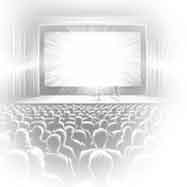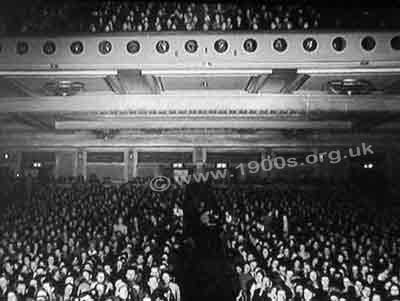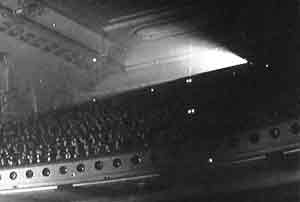Inside cinemas in their heyday

The elegance and space in old cinemas was magnificent. The grand foyer welcomed people in, and usherettes then guided them to the padded, raked seats, so arranged that everyone had a clear view of the large screen. This page attempts to bring to life the sense of wonder and awe that people of the past experienced inside a cinema. If anyone of today could experience it, what would strike them first of all would be the air quality from smoking - not that anyone minded at the time. Next, perhaps they would notice the courting couples.
____
By the webmaster: her early recollections with further research and contributions from others who lived at the time
First impressions
contributed by Desmond Dyer, recollections
Our Ritz cinema was almost certainly not unique in being really sumptuous inside, with everywhere except the toilets carpeted, and with superb decor and lighting.
The cinema foyer
When we first entered a cinema, we found ourselves in a reception area known as a foyer with a cashier's cubicle where we paid our money. Various colourful placards and a small sales stall and refreshment area were also there. The placards changed frequently, so that there was always something new for customers to admire.

Box office in the elegant foyer
The elegance and drama of the foyer
contributed by Desmond Dyer, recollections
During the showing of Caesar and Cleopatra with Claude Rains and Vivian Leigh in 1945, the whole building was transformed into an Egyptian Temple with props from the film.

A foyer arrangement for a particular programme.

A foyer arrangement for another programme. Photos courtesy of David Daniells.
From the foyer there was an elegant curved flight of stairs leading to the balcony - known as the circle - and a set of double doors leading to the one large auditorium. (Splitting cinemas up into several smaller theatres was years away.)
The auditorium
The auditorium was huge. This was a time when cinemas showed only one programme, rather than the several different ones in separate small theatres of today.

A large cinema auditorium. Screenshot from an old film.
The floor of the auditorium sloped upwards towards the back, some with steps. The difference in height was necessary for people to be able to see over the heads of those in front, although tall men and women with hats could still obscure. For the best view it was best to sit behind a small child - but never in front of one as they tended to kick and the jolt the seat in front of them which could be felt through the back of one's own seat.
The stalls and the balcony/circle
The seats in the main auditorium were known as the stalls. There were three sets of prices. The front stalls were the cheapest because necks cricked looking up at the screen, and the back stalls were the most expensive - a price that courting couples were glad to pay.

The stalls and the large balcony/circle
All the seats flipped up for cleaning and to allow people to move along a row.
The seats in the balcony/circle were the most expensive, particularly at the front of the balcony.
The stage and screen
At the front of the theatre was a stage with a large screen and thick curtains at either side which opened and closed to indicate the start and finish of the day's performance.
Behind the curtains, but in front of the screen was a fire curtain which I understood had, by law, to be raised and lowered once every day that the cinema was open.

Cinema stage with curtains across the screen. Photo courtesy of David Daniells.
Cinema organs
I was always fascinated by the colourful and brightly lit organ which played while customers were waiting for the film to begin. I can't remember what the organist played, but I clearly remember how the whole organ was raised up for all to see while the organist was playing, and then how it was slowly lowered to below eye level for the films.
I understand that there were two main makes of cinema and theatre organs in the UK: Wurlitzer and Christie, although Wikipedia lists orther makes.
The Christie organ
contributed by Peter Hammond
The Regal in Edmonton - where most of the photos on this page come from - had a superb 'Christie' organ with 4 manuals and 14 ranks of pipes. The console started life with a large glass surround, but that was damaged in the 1940s. In 1947 Wurlitzer rebuilt the console and fitted the wooden sides visible in the photo. So the glass sided photo is older than the wooden sided one. The man in the white suit is Phil Park, the organist at the Regal in the 1930s and 40s. My father used to visit the Regal in his teens.
The Regal organ still exists. It was removed from the Regal prior to the cinema's sad demolition and was installed in a hall in Barry, south Wales where it played for many years. More recently it was removed from there and is currently installed in a new arts centre elsewhere in South Wales.


The organ at the Regal cinema showing how it changed over time. The second photo is a Christie organ and is good enough to enlarge.

A cinema organ that raised up while no film was showing and sank down during a film. Screenshot from an old film.
Features of cinema organs
contributed by Peter Hammond
Cinema organs were pipe organs, similar to those in churches, but designed to sound more like orchestras. Only the organ console (the part the organist sits at) was visible and was often on a lift. The rest of the organ, which was usually a couple of tons or more of pipework and equipment, was situated behind a wall grill or under the stage.
In the same pit as the organ was space for an orchestra.
Cinema lavatories
There were customer lavatories, but I don't think I ever used them. See the following box for the recollections of Desmond Dyer.
contributed by Desmond Dyer, recollections
The toilets in our Ritz were 'a world apart' for most people. Compared to the outside loos at home and the Spartan and dim public toilets, the Ritz toilets were superb. They were fully tiled and well lit. They had hand basins with hot and cold running water and large mirrors, and there was lots of chrome. Everything was gleaming.
Air quality and smoking
Smoking was completely normal. It would have been considered extremely rude and inconsiderate to object. The air could be thick with smoke. How different from today! It is surprising that we didn't all get lung cancer.

The light from the cinema projector showing up in the smoky air above the audience's heads. Screenshot from an old film.
Litter and cleanliness
Because going to the cinema was regarded as a treat, it always seemed that people added to the quality of the experience by snacking on something. They could bring sweets and drinks in with them, buy from a bar in the foyer or buy from usherettes who would walk up and down the aisles during intervals with trays of ice creams for sale.
At the beginning of the afternoon and the end of the evening, the lights
'went up' but I don't remember them as particularly bright. With hindsight, I
dread to think of the grubby seats and floors, but it was dark and we probably
wouldn't have
noticed or worried anyway.
Use of litter fag ends: a cinema cleaner's story
contributed by Peter Johnson
We knew a lady who was a cleaner at the Regal in Edmonton. She would collect all the cigarette butts that were swept from the floor and take them home. Then she would sit at the kitchen table and with a sharp single edge razor blade would top and tail them, there were no tipped cigarettes in those days.
Then she would slit open the paper and create a pile of tobacco, to which she added a very small amount of fresh tobacco. This she sold to a local newsagents shop which was then sold on as 'under the counter' rolling mix. Some people called it 'cough mixture'.
Courting couples use of cinemas
Cinemas were one of the few places where courting couples could go to sit in the warm and relative seclusion of darkness. Again, how things have changed!
They sat in the back row which had a partition behind it, shielding them from the view of casual observers - although anyone who wanted to see them could easily do so.

A screen shot from scene in the comedy 'Dad's Army'. Although intended to be amusing, cinemas in the 1940s and 1950s really were like this, although the courting couples would have been younger than these actors.
It was well-known that such couples saw very little of what was being shown.
| sources | webmaster | contact |
Text and images are copyright
If you can add anything to this page or provide a photo, please contact me.



